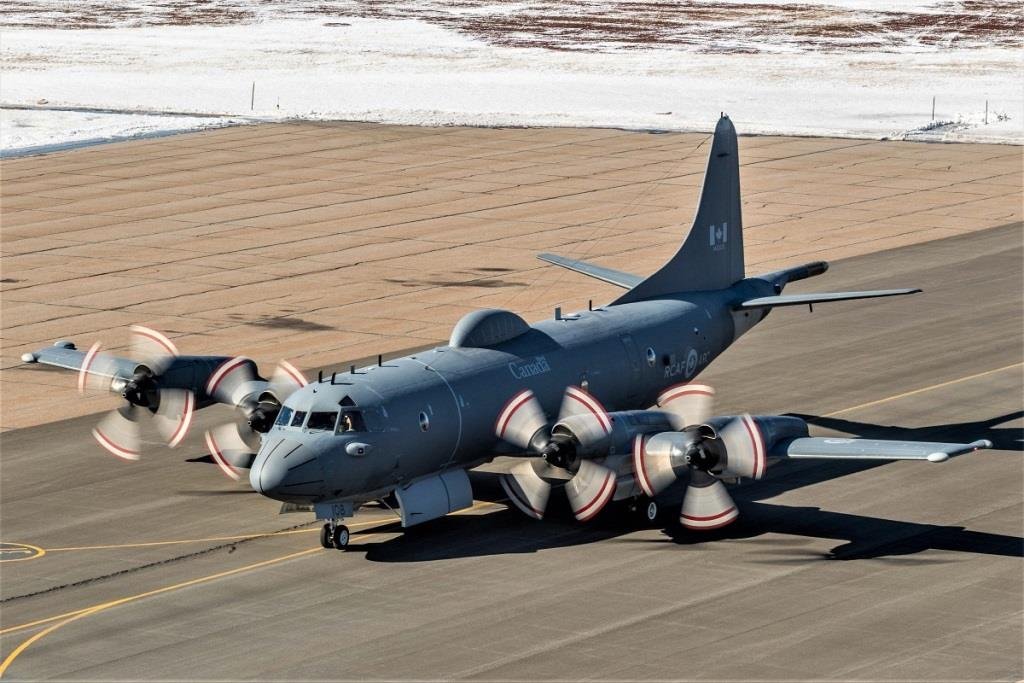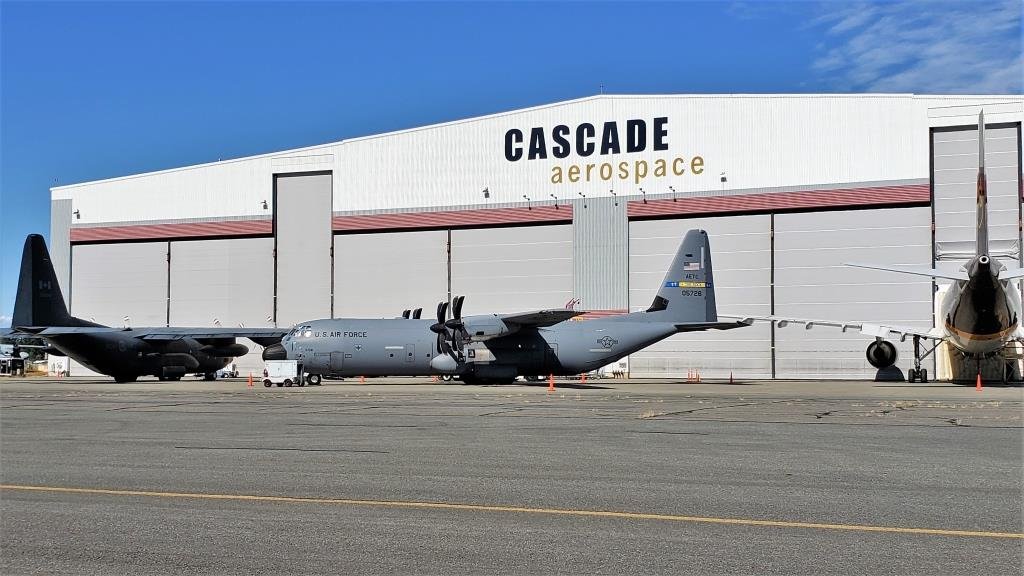IN-SERVICE SUPPORT - Mission Readiness AIR, LAND, SEA & SPACE
BY JOETEY ATTARIWALA
Mission Readiness
AIR, LAND, SEA & SPACE
With over 2,400 staff at operations across Canada, IMP Aerospace & Defence is known worldwide for delivering a wide breadth of innovative and tailored support solutions to all branches of the military as well as government and commercial operators in the space, air, land and sea sectors. The company is renowned for providing diverse support options on a wide variety of airframe platforms, and it provides customers with scalable solutions and support for their operational needs.
IMP Aerospace & Defence comprises five operating units consisting of IMP Aerospace, Cascade Aerospace, IMP Electronic Systems, IMP Aerostructures and IMP Naval & Land Services. In addition, the company also oversees a major project — the Canadian Search & Rescue Helicopter program.

CENTRES OF EXCELLENCE
Collectively, these units enable IMP to deliver products and services in all domains of aerospace and defence in Canada and internationally, including critical project management, in-service support (ISS), and maintenance, repair and overhaul (MRO) work. This highly skilled work enables the company to be recognized as a leader in the aerospace sector, especially through its established centres of excellence on the East and West coast of Canada. Together these centres support numerous fleets of the Royal Canadian Air Force (RCAF) and international air arms, and are a shining example of a success story that is paying dividends domestically and internationally.
The recognition of IMP as an industry leader is based on decades of investment that Canada has made to support the domestic aerospace industry. On the East Coast, IMP’s long-established work with maritime aircraft started with the legendary Lancaster, and continued with the CP-107 Argus, and the CP-140 Aurora aircraft of today. IMP’s East coast center of excellence also supported the venerable CH-124 Sea King maritime helicopter for its long service life. It is also a globally recognized maintainer of the AW101 medium lift helicopter, of which Canada operates the CH-149 Cormorant variant.
On the West Coast, Cascade Aerospace has established itself as a leading Canadian specialty aerospace and defence company trusted for its engineering and maintenance expertise for operators in the domestic and international military, government and commercial environments. The unit specializes in military transport and special mission aircraft, and it boasts a purpose built 235,000 square foot facility in Abbotsford, BC. Cascade has the distinction of being one of only two heavy maintenance centres in the world for the C-130J Super Hercules.
“Cascade has been doing work on the Hercules aircraft for over 17 years now, and that’s enabled us to develop a really capable and experienced workforce that lives in and around Abbotsford,” said Clark Bain, Vice President, Strategic Development for IMP Aerospace & Defence. “All of the export work for fleet maintenance and upgrades for military transport aircraft comes from the work that we started doing with Canada’s fleet of transport aircraft. With the introduction of C-130’s to Halifax, both facilities are constantly busy — in addition to Canadian aircraft, the company is currently working on a C-130 from Bangladesh; and a number of U.S. Air Force and U.S. Marine Corps C-130’s which are being upgraded to the Block 8.1 configuration on both coasts.”
According to IMP, the company is conducting more work internationally, which further solidifies the company as a global leader in supporting military transport aircraft. The company has a number of international contracts, particularly in the Asia-Pacific region.
“Right now, we have our specialists in Taiwan, Thailand, and Indonesia, and we’re primarily assisting those countries with doing rainbow fitting replacements for their C-130 aircraft,” Bain told CDR. “Not only do we have international C-130 customers come to both our facilities in Canada, but we’re taking our expertise abroad and helping folks in country, and of course, all of that started with the work that we do for Canada.”
Along with its facilities in Halifax and Abbotsford, IMP has satellite operations at CFB Trenton. This allows IMP to provide the Department of National Defence (DND) with on-site support for Canada’s fleet of legacy C-130 Hercules and C-130J Super Hercules aircraft, as well as the CT-114 which operate with the Snowbirds Air Demonstration Squadron. The unit also has an office in Ottawa, which is used for business development and customer relations.
SPACE DOMAIN
IMP’s expertise spans beyond aircraft alone — its Electronic Systems unit provides the military and aerospace industries with the design, manufacture, repair, overhaul, and product improvement of avionics, electronic systems, and wire harness assemblies. The unit is particularly specialized in wiring bundles for space applications, and regularly supports major players in the Canadian space industry. The company has products on the RADARSAT constellation of earth observation satellites; and the famous Canadarm on the International Space Station.
The Electronic Systems unit is particularly proud to be part of what is arguably the most significant space exploration mission in recent times — that being the James Webb Space Telescope — which is a joint effort of NASA, the Canadian Space Agency and the European Space Agency. For this application, IMP was selected to design, manufacture, and test a suite of qualification, engineering test and flight wiring harnesses for the telescope's Fine Guidance Sensor. These IMP-built harnesses are now operating 1.5 million kilometers away from earth.
The IMP Aerostructures unit is significant in that it specializes in manufacturing flight-critical aircraft assemblies and detail components, and operates as a one-stop shop, providing everything from program management and engineering services to finishing and assembly processes. The unit is a key supplier to major OEMs and tier 1 companies like Spirit AeroSystems.
CP-140 UPGRADES
If there is a Canadian success story, it is the RCAF’s CP-140 Aurora long-range maritime patrol aircraft. IMP is responsible for engineering, deep maintenance and upgrades of the aircraft, and their expertise with the Canadian fleet and other operators now sees the company as the sole Lockheed Martin approved P-3 Orion Service Centre in the world.
Canada has invested billions in the CP-140 which in recent years has undergone an extensive upgrade program dubbed the Aurora Incremental Modernization Project (AIMP). This project consists of 23 individual projects to acquire, integrate and install new mission systems and sensors onto the CP-140 for intelligence, surveillance and reconnaissance. The project has been executed in a phased approach with four Blocks — Blocks I, II and III are complete, and Block IV is in the implementation phase. The Government of Canada has also extended the life of the Aurora fleet with the Aurora Structural Life Extension Project (ASLEP) which involved replacing wings and horizontal stabilizers on the aircraft.
Current projections for the CP-140 fleet sees an Estimated Life Expectancy (ELE) of 2042, however the aforementioned structural upgrades and current flying rate could see the operational life extend out to 2050.
“A Maritime Patrol Aircraft is really just like a pickup truck. It’s what goes in the back of it and the training and expertise that the crews have, that decides whether an aircraft is operationally successful,” said Bain.
True to those words, a CP-140 detachment came out on top of all other participants at Exercise Sea Dragon 2022, a premier multinational anti-submarine exercise hosted by the U.S. Navy.
Canada’s investment in the Aurora fleet means the aircraft are essentially new planes however, pathways exist to improve the platform even further. These efforts can all be done by IMP in Canada, and can include a new cockpit, new propellers, and an upgrade to the engines, among others.
Bain added, “We do a lot of export work on P-3 Orion aircraft partly because we work on the RCAF’s Auroras, so that work delivers significant economic benefits for Canada.”
Indeed, numerous allies have IMP maintain and upgrade their P-3 fleets. For example, the Chilean Navy has significantly upgraded their Orions, including a new glass cockpit. This non-recurring engineering was done at IMP and is now available for any operator who wishes to improve their aircraft.
Work like this enabled IMP Aerospace to sign a significant sub-contract with General Dynamics Mission Systems–Canada (GDMS-C) to design and implement a Block I Avionics Update for the Portuguese Air Force (PRTAF).
This effort will modify the PRTAF P-3C CUP+ fleet with significant new capabilities including upgraded Identification Friend or Foe Transponder (IFFT), Link-16 communications, and Data Management System (DMS). The IMP engineering design effort has already commenced, and a prototype aircraft is currently scheduled for induction in October 2023.
CH-149 CORMORANT 
In the past 23 years, IMP has established itself as a globally recognized maintainer of the AW101 helicopter, of which the CH-149 Cormorant is a variant.
IMP manages the Canadian Search & Rescue Helicopter program on behalf of the RCAF, and runs it as a separate program because the tempo is very different from other aspects of the business. IMP provides total in-service support for the Cormorant, so short of flying the aircraft and jumping out of the back of it, almost every other aspect of supporting this critical Search and Rescue (SAR) capability is the responsibility of IMP.
“IMP is effectively the fleet manager or an extension of the Weapon System Manager for the Cormorant fleet,” Bain explained. “Because we’re managing the fleet on behalf of the Air Force, we have to make decisions 24/7 and 365, sometimes in minutes. It operates on a very, very different tempo to the rest of the business, so we hived it off and kept it as a completely separate operating unit in order to be responsive to the mission needs.”
Canada’s investment with the Cormorant has enabled IMP to become one of the only third-party maintainers of the AW101 helicopter in the world. The company’s excellence in this area was recognized at the international AW101 user group, which stated that Canada has higher fleet availability than anyone else in the world by a strong margin, and less than half the maintenance hours per flying hour of the next nearest operator.
The Cormorant Mid-Life Upgrade (CMLU) contract was formally awarded to Leonardo in December 2022 and will be executed by Team Cormorant, a collaboration of Leonardo supported by principal Canadian subcontractor IMP Aerospace & Defence, together with GE Canada, and Collins Aerospace Canada.
The $1 billion contract for the CMLU Project is for 16 aircraft in total, comprising 13 Cormorant helicopters currently in-service, and the augmentation of a further three aircraft. The CMLU is based on Norway’s AW101 SAR helicopter, and will enhance the platform's systems and technologies, ensure compliance with emerging airspace requirements, and extend the life expectancy of the fleet to at least 2042. According to Leonardo, the CMLU Project will include: state-of-the-art avionics, a new glass cockpit, more powerful digitally-controlled engines, wireless in-cabin communications, the latest SAR sensors including Electro Optical Infra-Red device and Mobile Phone Detection Location System – all of which enable less search and more rescue.
The first three CMLU aircraft will be built in Yeovil, England, while the remainder of the fleet will be assembled at IMP’s facilities in Halifax.
IMP is uniquely positioned to maintain the rotary-wing SAR capability through transition to the new CMLU fleet and beyond. The company has been the In-Service Support provider for decades, and has an exclusive teaming agreement with the OEM for future Cormorant ISS and as such provides the lowest risk sustainment solution for the future of this vital fleet.
NEW CAPABILITIES FOR THE SNOWBIRDS
In late February, IMP Aerospace & Defence announced the first flight of the RCAF’s CT-114 Tutor Avionics Upgrade prototype aircraft. This flight followed over two years of development, design, consultation and partnership between the RCAF, L3Harris, and IMP Aerospace.
Implemented by IMP Aerospace at CFB Trenton, the Avionics Update expands the Tutor’s existing capabilities while adding extra safety features. The addition of the off-the-shelf Garmin GDU 1060 Electronic Flight Displays simplifies navigation, increases situational awareness, and reduces pilot workload. In addition to the new Cockpit Voice and Flight Data Recorders, the Tutor becomes ADS-B compliant, allowing its continued operation in controlled airspace across North America.
With the second aircraft modification well underway, IMP Aerospace is committed to upgrading a total of 20 CT-114 Tutors for the Snowbirds.
CANADA’S DEFENCE STRATEGY MUST VALUE CANADIAN CONTENT 
IMP Aerospace & Defence is continuously seeking ways to support Canada and its allies. Domestically, the company is part of Team Poseidon, which is competing the Boeing P-8A Poseidon for the Canadian Multi-Mission Aircraft (CMMA) project. In addition, IMP is tracking the Remotely Piloted Aircraft System (RPAS) project, and the Strategic Tanker Transport Capability (STTC) project.
Now that Canada has formally announced the F-35 as the winner of the Future Fighter Capability Project (FFCP), aerospace companies across Canada are looking for ways to support and sustain the aircraft in Canada. IMP will certainly be among those companies attending the upcoming Industry Day that Canada intends to hold, and will be keen to hear the Government’s vision for the sustainment of this new fleet.
There is no doubt that Canada's defence industry does well internationally because Canada buys from it and Canada supports it. The Government is demonstrating a growing impetus of recompeting contracts for the sake of competition, but such effort flies in the face of everything the country has done to establish centres of excellence like those at IMP Aerospace, Cascade Aerospace and others. Recompeting work which normally goes to centres of excellence would undermine the decades of investment that Canada has already made. In addition, if a new company were to attempt to develop such capabilities, that would take many years and it would inject undue risk at a time when military services are already faced with manpower pressures for technical specialists and support staff.
IMP Aerospace & Defence is a success story for Canada’s investment in the aerospace and defence sector, but without Canada continuing to support established centers of excellence like theirs, and others, the opportunity of export work disappears for the industry and for the country. Care must be taken to protect what Canada has invested so much in.
Joetey Attariwala is CDR’s Aviation Editor


